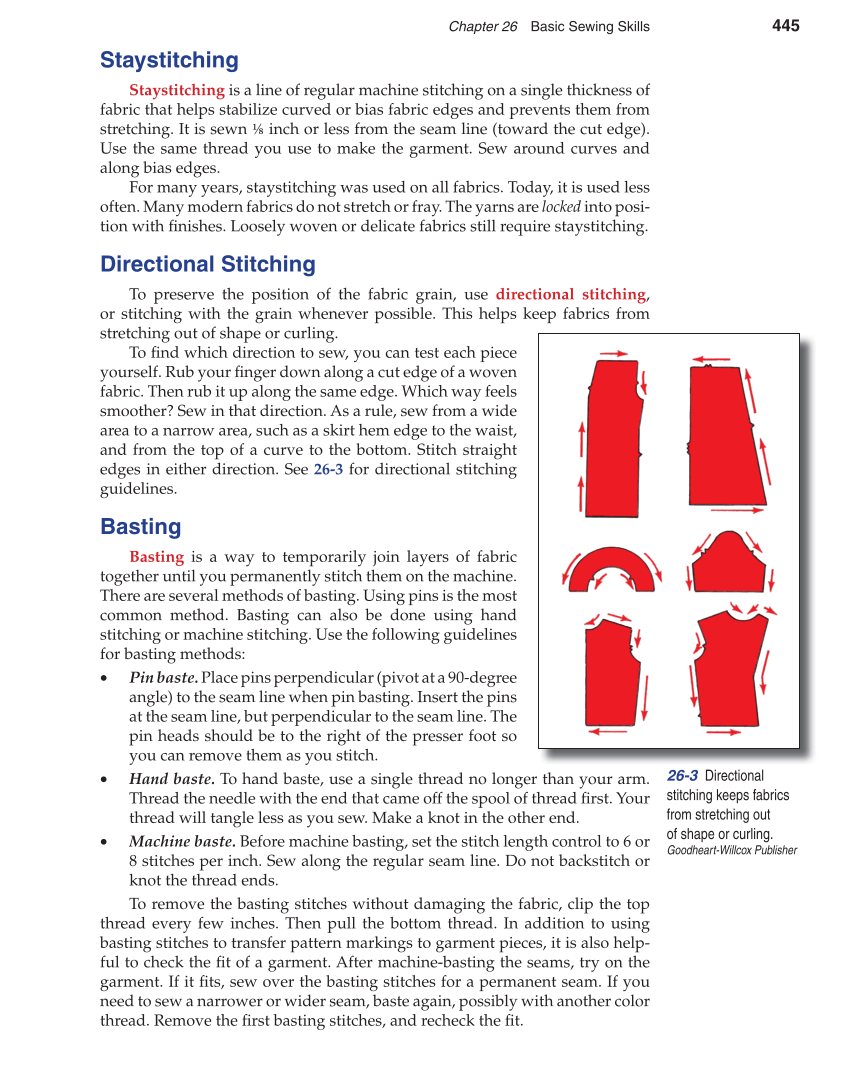Chapter 26 Basic Sewing Skills 445 Staystitching Staystitching is a line of regular machine stitching on a single thickness of fabric that helps stabilize curved or bias fabric edges and prevents them from stretching. It is sewn ⅛ inch or less from the seam line (toward the cut edge). Use the same thread you use to make the garment. Sew around curves and along bias edges. For many years, staystitching was used on all fabrics. Today, it is used less often. Many modern fabrics do not stretch or fray. The yarns are locked into posi- tion with fi nishes. Loosely woven or delicate fabrics still require staystitching. Directional Stitching To preserve the position of the fabric grain, use directional stitching, or stitching with the grain whenever possible. This helps keep fabrics from stretching out of shape or curling. To fi nd which direction to sew, you can test each piece yourself. Rub your fi nger down along a cut edge of a woven fabric. Then rub it up along the same edge. Which way feels smoother? Sew in that direction. As a rule, sew from a wide area to a narrow area, such as a skirt hem edge to the waist, and from the top of a curve to the bottom. Stitch straight edges in either direction. See 26-3 for directional stitching guidelines. Basting Basting is a way to temporarily join layers of fabric together until you permanently stitch them on the machine. There are several methods of basting. Using pins is the most common method. Basting can also be done using hand stitching or machine stitching. Use the following guidelines for basting methods: • Pin baste. Place pins perpendicular (pivot at a 90-degree angle) to the seam line when pin basting. Insert the pins at the seam line, but perpendicular to the seam line. The pin heads should be to the right of the presser foot so you can remove them as you stitch. • Hand baste. To hand baste, use a single thread no longer than your arm. Thread the needle with the end that came off the spool of thread fi rst. Your thread will tangle less as you sew. Make a knot in the other end. • Machine baste. Before machine basting, set the stitch length control to 6 or 8 stitches per inch. Sew along the regular seam line. Do not backstitch or knot the thread ends. To remove the basting stitches without damaging the fabric, clip the top thread every few inches. Then pull the bottom thread. In addition to using basting stitches to transfer pattern markings to garment pieces, it is also help- ful to check the fi t of a garment. After machine-basting the seams, try on the garment. If it fi ts, sew over the basting stitches for a permanent seam. If you need to sew a narrower or wider seam, baste again, possibly with another color thread. Remove the fi rst basting stitches, and recheck the fi t. 26-3 Directional stitching keeps fabrics from stretching out of shape or curling. Goodheart-Willcox Publisher
